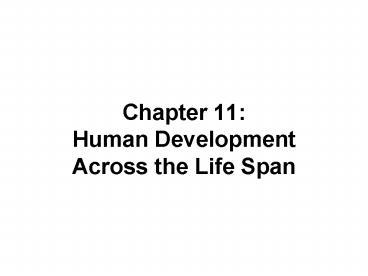Chapter 11: Human Development Across the Life Span - PowerPoint PPT Presentation
1 / 30
Title:
Chapter 11: Human Development Across the Life Span
Description:
Chapter 11: Human Development Across the Life Span * * A developing baby and its mother are linked through the placenta, and a mother s behaviors can affect the ... – PowerPoint PPT presentation
Number of Views:243
Avg rating:3.0/5.0
Title: Chapter 11: Human Development Across the Life Span
1
Chapter 11Human Development Across the Life Span
2
Progress Before BirthPrenatal Development
- 3 phases
- germinal stage first 2 weeks
- conception, implantation, formation of placenta
- embryonic stage 2 weeks 2 months
- formation of vital organs and systems
- fetal stage 2 months birth
- bodily growth continues, movement capability
begins, brain cells multiply - age of viability
3
Figure 11.1 Overview of fetal development
4
Environmental Factorsand Prenatal Development
- Maternal nutrition
- Malnutrition linked to increased risk of birth
complications, neurological problems, and
psychopathology - Maternal drug use
- Tobacco, alcohol, prescription, and recreational
drugs - Fetal alcohol syndrome
5
Environmental Factorsand Prenatal Development
- Maternal illness
- Rubella, syphilis, mumps, genital herpes, AIDS,
severe influenza - Prenatal health care
- Prevention through guidance
6
The Childhood Years Motor Development
- Basic Principles
- Cephalocaudal trend head to foot
- Proximodistal trend center-outward
- Maturation gradual unfolding of genetic
blueprint - Developmental norms median age
- Cultural variations
7
Easy and Difficult BabiesDifferences in
Temperament
- Longitudinal vs. cross-sectional designs
- Thomas, Chess, and Birch (1970)
- 3 basic temperamental styles
- easy 40
- slow-to-warm-up 15
- difficult 10
- mixed 35
- stable over time
8
Easy and Difficult BabiesDifferences in
Temperament
- Kagan Snidman (1991)
- Inhibited vs. uninhibited temperament
- inhibited 15 - 20
- uninhibited 25 - 30
- stable over time, genetically based
9
Figure 11.4 Longitudinal versus cross-sectional
research
10
Early Emotional Development Attachment
- Separation anxiety
- Ainsworth (1979)
- The strange situation and patterns of attachment
- Secure
- Anxious-ambivalent
- Avoidant
11
Early Emotional Development Attachment
- Developing secure attachment
- Bonding at birth
- Daycare
- Cultural factors
- Evolutionary perspectives on attachment
12
Stage Theories of Development Personality
- Stage theories, three components
- progress through stages in order
- progress through stages related to age
- major discontinuities in development
- Erik Erikson (1963)
- Eight stages spanning the lifespan
- Psychosocial crises determining balance between
opposing polarities in personality
13
Figure 11.7 Stage theories of development
14
Figure 11.8 Eriksons stage theory
15
Stage Theories Cognitive Development
- Jean Piaget (1920s-1980s)
- Assimilation/ Accommodation
- 4 stages and major milestones
- Sensorimotor
- Object permanence
- Preoperational
- Centration, Egocentrism
- Concrete Operational
- Decentration, Reversibility, Conservation
- Formal Operational
- Abstraction
16
Figure 11.9 Piagets stage theory
17
Figure 11.10 Piagets conservation task
18
Figure 11.11 The gradual mastery of conservation
19
The Development of Moral Reasoning
- Kohlberg (1976)
- Reasoning as opposed to behavior
- Moral dilemmas
- Measured nature and progression of moral
reasoning - 3 levels, each with 2 sublevels
- Preconventional
- Conventional
- Postconventional
20
Figure 11.14 Kohlbergs stage theory
21
Adolescence Physiological Changes
- Pubescence
- Puberty
- Secondary sex characteristics
- Primary sex characteristics
- Menarche
- Sperm production
- Maturation early vs. late
- Sex differences in effects of early maturation
22
Figure 11.16 Physical development at puberty
23
Adolescence Neural Changes
- Increasing myelinization
- Synaptic pruning
- Changes in prefrontal cortex
24
Figure 11.17 The prefrontal cortex
25
Figure 11.18 Peer influence on risk taking
26
The Search for Identity
- Erik Erikson (1968)
- Key challenge - forming a sense of identity
- James Marcia (1988)
- 4 identity statuses
- Foreclosure
- Moratorium
- Identity Diffusion
- Identity Achievement
27
Figure 11.20 Marcias four identity statuses
28
Emerging Adulthood as a New Developmental Stage
- Search for identity extends into adulthood
- Ages 18 25 have become a distinct transitional
stage of life - Characterized by
- subjective feeling of transition
- age of possibilities
- self-focused
- period of identity formation
29
The Expanse of Adulthood
- Personality development
- Social development
- Career development
- Physical changes
- Cognitive changes
30
Figure 11.25 Age and the stability of primary
mental abilities































